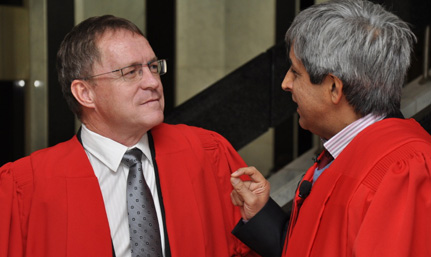|
 |
Dawie Roodt and Prof Adam Habib
30 May 2013 |
The Marikana incident is a bitter moment for South Africa's new political establishment; a tragedy on the same scale as Sharpeville and the Soweto massacre.
This is how Prof Adam Habib, Vice-Chancellor and Principal designate of the University of the Witwatersrand, described the sorrow during the CR Swart Memorial Lecture hosted by the Department of Political Studies and Governance.
Speaking on the topic The Post-Marikana landscape in South Africa, Prof Habib and Dawie Roodt, Chief Economist and Director of the Efficient Group, gave their views on the political and economic challenges confronting the country.
Prof Habib, a well-known political commentator, explained to the fully-packed CR Swart Auditorium how this tragedy provoked a national soul-searching.
Referencing from his highly-anticipated book South Africa's Suspended Revolution, Hopes and Prospects, Prof Habib said the difficulty Marikana poses is the challenge of inequality. According to him, inequality is the single biggest challenge of the South African society. He firmly believes that taking responsibility for poverty is a moral necessity. "Addressing poverty is absolutely crucial if we want to be a humane society."
In his presentation, Roodt informed the audience regarding recent data on population growth, unemployment and dependency ratios. These statistics gave an indication of how the country is doing. The economist said the only way to address unemployment, inequality and poverty is through economic growth.
"If we want to do something about inequality, we have to do something about skills – particularly skills for women. We must make it easier for people to get jobs," Roodt emphasised.